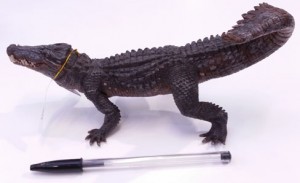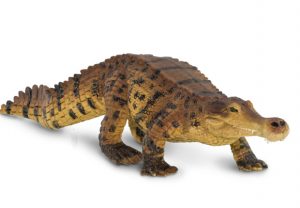Weird and Wonderful Crocodiles of the Mesozoic
A team of scientists led by Professor Paul Sereno, palaeontologist at the University of Chicago and an acknowledged expert on the Mesozoic fauna of North Africa has uncovered a range of bizarre and very diverse ancient crocodiles. These new types of reptilian predator have been given nicknames that reflect their place in the ancient Saharan eco-system. There is RatCroc, the gigantic BoarCroc, as large as any living crocodile species today, as well as DogCroc, DuckCroc and the curious PancakeCroc.
The fossils of these curious animals have been recovered from dig sites in present-day Niger and Morocco and an analysis of the fossils is provided in the scientific journal “ZooKeys”. During the Cretaceous these parts of Africa were lush, river deltas and plains which teemed with life, including many dinosaurs and ancient crocodilians.
Sereno and colleagues have been scouring the harsh deserts of northern Africa since 2000 for evidence of a “lost world” of crocodilian ancestors. Although, not that closely related to modern types of crocodile, the Neosuchians, these ancient animals may have been the ancestors of our present day crocodiles, they certainly demonstrate that crocodiles evolved to fill a number of niches in the Cretaceous.
For instance, the rodent-like RatCroc had buckteeth for rooting through the ground after tubers or simple animals.
The flat-bodied PancakeCroc was the “ultimate sit-and-wait predator,” Sereno said. The animal would lie motionless and “wait for something stupid” to swim into its rail-thin, 3-foot-long (0.9-metre-long) jaws, which were lined with rows of spiky teeth. The jaw of this particular animal are in some ways similar to the jaws of a modern day Gharial. It is likely this type of crocodile was an almost exclusive fish eater.
DuckCroc, evolved along a different evolutionary path. It had a long, smooth, sensitive nose to poke through vegetation as well as hook-shaped teeth to snag frogs and small fish in shallow water. Although, the fossil record for amphibians is relatively poor, it is likely that the lush, slow flowing rivers in which DuckCroc lived teemed with frogs and other small amphibians.
And the plant-eating DogCroc had lanky legs that meant it was likely spry enough to run into the water if threatened. Some types of crocodile today, such as the Australian Freshwater crocodile (Crocodylus johnstoni), are capable of running very fast, they rise up on their legs and move very rapidly with undulating body and tail movements in a side-to-side motion, heading usually for the safety of the nearest water. They can easily out pace an athlete over rough ground. The study of the fossilised bones of DogCroc indicate that this ancient crocodile may also have been capable of this behaviour.
The largest crocodile in the study, the one named BoarCroc, seems to have grown in excess of 6 metres long, and although not in the same size league as Sarcosuchus or Deinosuchus it would have been a formidable ambush predator. It would have attacked dinosaurs and other large animals that came down to the water to drink. BoarCroc has been described as a “Sabre-toothed cat in armour”, the three sets of fangs, so long they jutted above and below the jaw when shut gave this crocodile a fearsome bite. Once these reinforced, armoured jaws had snapped shut, the victim would have had little chance of escape.
The Papo Kaprosuchus (BoarCroc) Model
Picture credit: Everything Dinosaur.
To view the Papo Kaprosuchus (BoarCroc) and the other prehistoric figures in the Papo “Les Dinosaures” range: Papo Dinosaur and Prehistoric Animal Figures.
Photographs released by National Geographic show Professor Paul Sereno and Professor Hans Larsson carefully excavating the fossil skull of the Cretaceous giant crocodile nicknamed BoarCroc. Professor Sereno is working on the back of the skull, whilst his associate Professor Larsson removes fragments of the sandstone matrix from around teeth in the fossil jaws.
Commenting on the study, palaeontologist Hans Dieter-Sues of the National Museum of Natural History in Washington D. C. stated:
“Gondwana had lots of real oddballs”.
He went on to add:
“For somebody who has studied a lot of fossil Crocodilyforms, I’m fascinated by these creatures”.
Commenting on the nimble and speedy nature of some of the specimens; the research team have suggested that crocodilian ancestors could run and swim with equal dexterity, this may have given them a leg-up when escaping predators and perhaps help them survive the end Cretaceous mass extinction event.
Some ancient crocs must have survived the mass extinction event that wiped out the dinosaurs about 66 million years ago. Being nimble on land and in water suggests the crocodile cousins may have taken refuge from environmental catastrophe in bodies of fresh water, where modern many types of modern-day crocodilians still thrive; concluded the research team.
The fossils have been dated to approximately the midCretaceous period (112-100 million years ago). These animals would have shared their environment with Sarcosuchus (S. imperator), one of the largest crocodiles of the Mesozoic, a 12-metre-long giant that may have weighed as much as 8 tonnes.
A Model of a Sarcosuchus (Prehistoric Crocodile0
To view a model of Sarcosuchus and other prehistoric animals we suggest you take a look at the extensive Wild Safari Prehistoric World model series: Safari Ltd. Wild Safari Prehistoric World.
Christopher Brochu, a palaeontologist at the University of Iowa, said that it’s hard to tell if the ancient crocs really galloped. Reflecting on the habits and behaviour seen with extant crocodile species (those that are around today), he stated that it is possible that the rapid-running gait developed in true crocodiles, the Neosuchia. He urged caution, when superimposing the behaviour seen in animal’s alive today on extinct species.
No matter how crocodiles moved, these fossils show how adaptable the basic crocodylian body plan is and the Alligators, Caimen, Gharials and Crocodiles around today is proof enough of the ability of this type of animal to survive.
Photographs in the media show Professor Paul Sereno behind the skull of the giant Sarcosuchus with the tusked BoarCroc to his left, the long-jawed Pancake Croc in the front with RatCroc, DogCroc and DuckCroc models shown at the front of the photo.








Leave A Comment